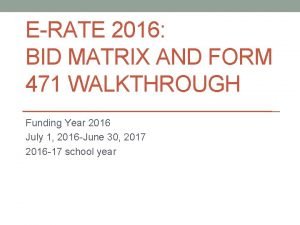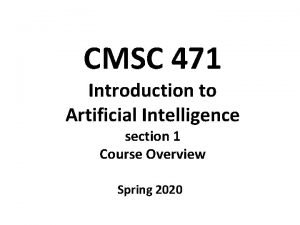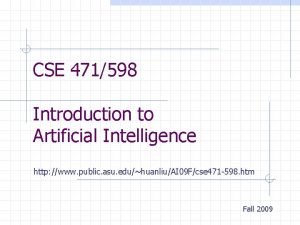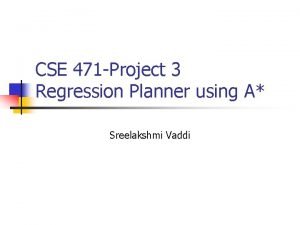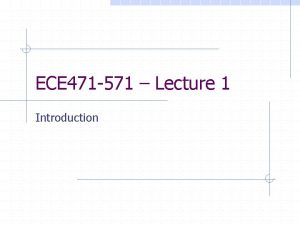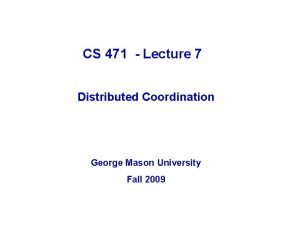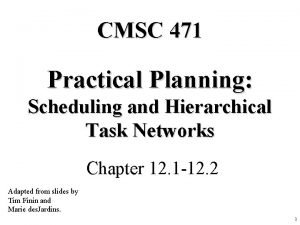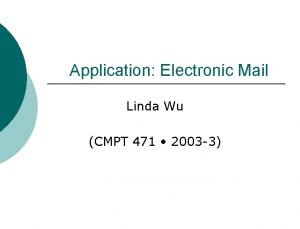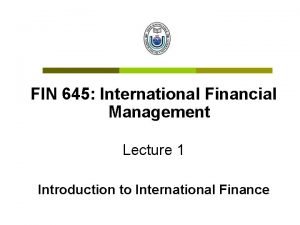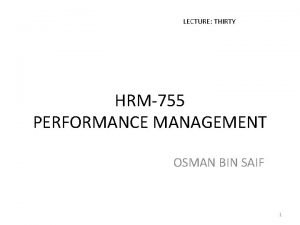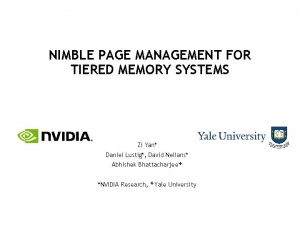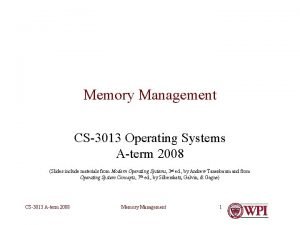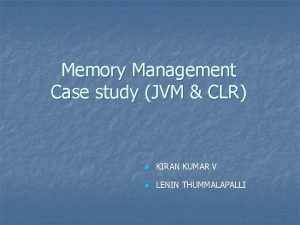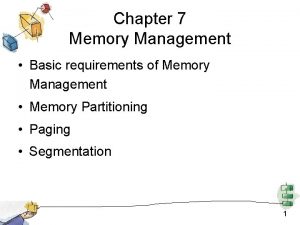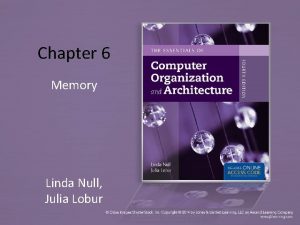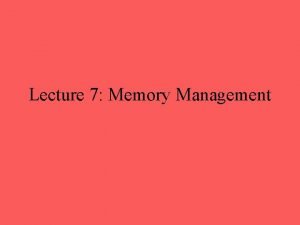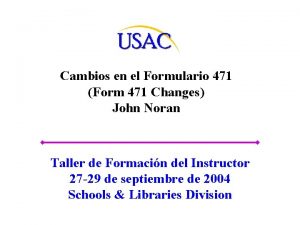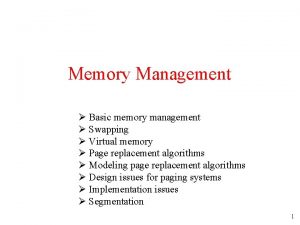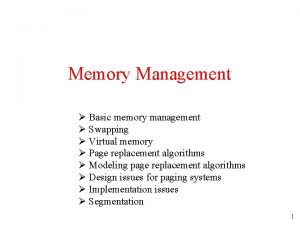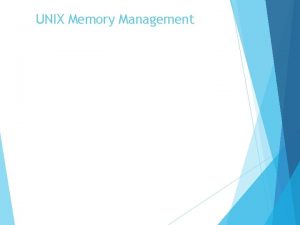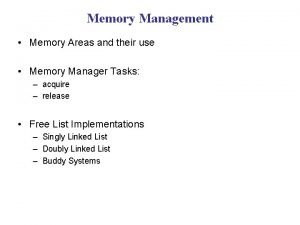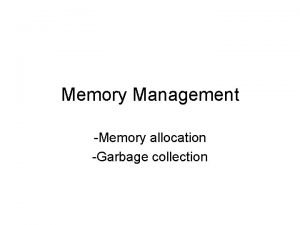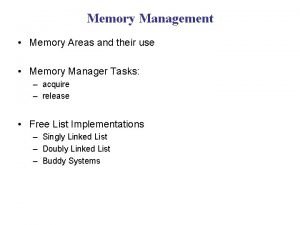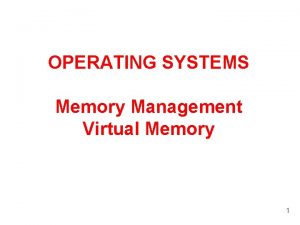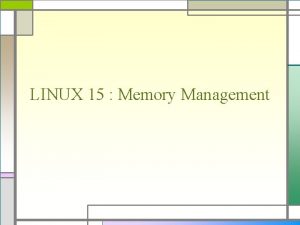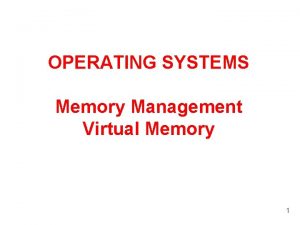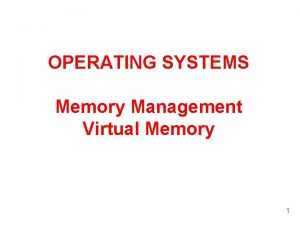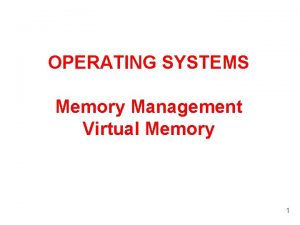CS 471 Lecture 8 Memory Management Ch 8


















































- Slides: 50

CS 471 - Lecture 8 Memory Management Ch. 8 George Mason University Fall 2009

Memory Management § § § Logical and Physical Address Spaces Contiguous Allocation Paging Segmentation Virtual Memory Techniques (Next Lecture) GMU – CS 571 8. 2

Memory Management § Memory density available for constant dollars tends to double every 18 months. § Why bother about memory management? § Parkinson’s Law: “Data expands to fill the space available for storage” § Emerging memory-intensive applications § Memory usage of evolving systems tends to double every 18 months. GMU – CS 571 8. 3

Background § § § Program must be brought (from disk) into memory and placed within a process for it to be run Main memory and registers are only storage CPU can access directly Register access in one CPU clock (or less) Main memory access can take many cycles Cache sits between main memory and CPU registers Protection of memory required to ensure correct operation GMU – CS 571 8. 4

Basic Concepts § Multiple processes typically take space in main memory at the same time § How to adjust the degree of multiprogramming to maximize CPU utilization? § Suppose average process computes only 20% of time it is sitting in memory and does I/O 80% of time. § Probabilistic view: CPU Utilization = 1 – xn where x is the average ratio of I/O time to process lifetime in memory, and n is the degree of multiprogramming. GMU – CS 571 8. 5

Multiprogramming Degree of multiprogramming § GMU – CS 571 CPU utilization as a function of the number of processes in memory and their degree of I/O. 8. 6

Basic Concepts § Multiple processes typically take space in main memory at the same time § Address binding § Allocation of space in main memory – contiguous vs. non-contiguous GMU – CS 571 8. 7

Binding of Instructions and Data to Memory ü Address binding of instructions and data to memory addresses can happen at three different stages. § § § Compile time: If the memory location is known a priori, absolute code can be generated. Must recompile code if starting location changes. Load time: Must generate relocatable code if memory location is not known at compile time. Execution time: Binding delayed until run-time if the process can be moved during its execution from one memory segment to another. Need hardware support for address maps (e. g. base and limit registers). GMU – CS 571 8. 8

Address Binding (Cont. ) PROGRAM 1024 JUMP X X PROGRAM LOAD Y GMU – CS 571 800 LOAD 1010 LOAD 2034 DATA PROGRAM JUMP 800 JUMP 1824 Y 0 DATA 2034 DATA 1010 8. 9

Logical vs. Physical Address Space § The concept of a logical address space that is bound to a separate physical address space is central to proper memory management. • Logical address – generated by the CPU; also • § referred to as virtual address. Physical address – address seen by the memory unit. Logical and physical addresses are the same in compile-time and load-time address-binding schemes; they differ in execution-time addressbinding scheme. GMU – CS 571 8. 10

Memory-Management Unit (MMU) § Hardware device that maps logical address to physical address for execution time binding. § In a simple MMU scheme, the value in the relocation (or, base) register is added to every address generated by a user process at the time it is sent to memory. § The user program deals with logical addresses; it never sees the real physical addresses. GMU – CS 571 8. 11

Dynamic relocation using a relocation register GMU – CS 571 8. 12

Use of Relocation and Limit Registers Hardware Support for Relocation and Limit Registers GMU – CS 571 8. 13

Contiguous Allocation § Processes (that are eligible for the CPU) are placed to the main memory in contiguous fashion § Can all of a program’s data and code be loaded into memory? • Dynamic loading • Dynamic linking § How to partition the memory across multiple processes? • Fixed partitioning • Dynamic partitioning GMU – CS 571 8. 14

Contiguous Allocation (Cont. ) § Fixed Partitioning • Divide the memory into fixed-size partitions • One process/partition • The degree of multiprogramming is bounded by the • • GMU – CS 571 number of partitions. When a partition is free, a process is selected from the input queue and is loaded into memory OS keeps track of which partitions are free and which are in use. 8. 15

Contiguous Allocation with Fixed-Size Partitions Process 1 Partition 1 Process 2 Process 1 Process 3 Partition 2 Process 3 Partition 3 Process 4 GMU – CS 571 8. 16 Process 2

Contiguous Allocation (Cont. ) § Dynamic Partitioning • Partitions are created dynamically, so that each • • • GMU – CS 571 process is loaded into a partition of exactly the size that it will need. Hole – block of available memory; holes of various size are scattered throughout memory. When a process arrives, it is allocated memory from a hole large enough to accommodate it. Operating system maintains information about: a) allocated partitions b) free partitions (holes) 8. 17

Contiguous Allocation with Variable-Size Partitions Process 1 Process 2 Main Memory Process 2 Process 3 Process 4 GMU – CS 571 8. 18

Dynamic Storage-Allocation Problem How to satisfy a request of size n from a list of free holes? § § First-fit: Allocate the first hole that is big enough. Best-fit: Allocate the smallest hole that is big enough. • Must search the entire list, unless ordered by size. Produces the smallest leftover hole. § Worst-fit: Allocate the largest hole. § Next-fit: Starts to search from the last allocation made, chooses the first hole that is big enough. § First-fit and best-fit better than worst-fit in terms of storage utilization. • Produces the largest leftover hole. GMU – CS 571 8. 19

Fragmentation Problem § Internal Fragmentation – allocated memory may be slightly larger than requested memory; the unused memory is internal to a partition. • Contiguous allocation with fixed-size partitions has the internal fragmentation problem § External Fragmentation – total memory space exists to satisfy a request, but it is not contiguous. • Contiguous allocation with variable-size partitions has • § the external fragmentation problem 50 -percent rule: Even with an improved version of First Fit, given N allocated blocks, another N/2 blocks will be lost to external fragmentation! (on the average) Memory Compaction (for execution time address binding) GMU – CS 571 8. 20

Paging § § § § A memory management scheme that allows the physical address space of a process to be non-contiguous. Divide physical memory into fixed-sized blocks called frames. Divide logical memory into blocks of same size called pages. Any page can go to any free frame To run a program of size n pages, need to find n free frames and load program. Set up a page table (one per process) to translate logical addresses (generated by process) to physical addresses. External Fragmentation is eliminated. Internal fragmentation is a problem. GMU – CS 571 8. 21

Paging Example 0 1024 2048 3072 Frame 0 Frame 1 Frame 2 Frame 3 0 1024 2048 3072 4093 A’s Page 0 Page 1 Page 2 A’s Page 3 A’s Page 1 Logical Address Space of Process A A’s Page 2 16383 Frame 15 16383 Main Memory GMU – CS 571 8. 22

Address Translation Scheme § § Observe: The simple limit/relocation register pair mechanism is no longer sufficient. m-bit logical address generated by CPU is divided into: • Page number (p) – used as an index into a page table which contains base address of each page in physical memory. • Page offset (d) – combined with base address to define the physical memory address that is sent to the memory unit. GMU – CS 571 8. 23

Address Translation Architecture GMU – CS 571 8. 24

Address Translation Architecture The length of the page table entry can be bigger than the required number of bits for the physical address For example, the physical address 24 bits, d = 5, then the page table entry is >= 24 -5 d = 5 => page size 2^5 Physical address 24 bits => # of frames = (2^24)/2^5 = 2^19 Most memories are byte (8 -bit) addressable There are 16 or 32 -bit word addressable GMU – CS 571 8. 25

Paging Example Consider some logical addresses: 6 - 0110 13 - 1101 32 -byte memory and 4 -byte pages GMU – CS 571 8. 26

Free Frames OS needs to manage physical memory and keep track of what frames are available (typically using a ‘frame table’) Before allocation GMU – CS 571 8. 27 After allocation

Hardware Support for Page Table § § Option: keep page table in registers • Fast • Not realistic if page table is large • Must reload these registers to run the process Option: Keep the page table in memory • Page-table base register (PTBR) points to the page table • • GMU – CS 571 location. Page-table length register (PTLR), if it exists, indicates the size of the page table. In this scheme every data/instruction access requires two memory accesses- one for the page table and one for the data/instruction. 8. 28

Associative Memory § § The two memory access problem can be solved by the use of a special fast-lookup hardware cache called translation look-aside buffer (TLBs). TLB is an associative, high speed memory (expensive). Page # Frame # Address translation (A´, A´´) • If page A´ is in associative register, get frame # out. • Otherwise get frame # from page table in memory • Typically, TLB contains 64 – 1024 entries not all pages are in the TLB. GMU – CS 571 8. 29

Paging Hardware With TLB GMU – CS 571 8. 30

Translation Look-Aside Buffer § Works like a cache – when we have a ‘miss’ want to add that info to the TLB § When we want to add a new entry to a full TLB, one entry must be replaced. Many different policies LRU (Least Recently Used), random, … § Some entries can be wired down (non removable) § Some TLB’s store address-space identifiers (ASIDs) to provide address space protection § What if TLB does not support separate ASIDs? TLB must be flushed when a new process is selected. GMU – CS 571 8. 31

Effective Access Time § § How does the paging affect the memory access time with or without TLB? TLB Hit ratio – percentage of times that a page number is found in TLB. Example: Assume that in the absence of paging, effective memory access time is 100 nanoseconds (computed through the cache hit ratio and cache memory/main memory cycle times). § Assume that Associative Lookup is 20 nanoseconds § Assume TLB Hit ratio is 80% § Effective Access Time (EAT) EAT = 0. 8 * 120 + 0. 2 * 220 = 140 nanoseconds GMU – CS 571 8. 32

Hierarchical Page Tables § Having page tables with more than one million entries is not uncommon in modern architectures. § Break up the logical address space into multiple page tables. § A simple technique is a two-level page table (forward-mapped page table in Pentium II. ). GMU – CS 571 8. 33

Two-Level Page-Table Scheme GMU – CS 571 8. 34

Two-Level Paging Example § § § A logical address (on 32 -bit machine with 4 KByte page size) is divided into: • a page number consisting of 20 bits • a page offset consisting of 12 bits Since the page table is paged, the page number is further divided into: • a 10 -bit page number • a 10 -bit page offset Thus, a logical address is as follows: where p 1 is an index into the outer page table, and p 2 is the displacement within the page of the outer page table. GMU – CS 571 8. 35

Address-Translation Scheme § Address-translation scheme for a two-level 32 bit paging architecture GMU – CS 571 8. 36

Multiple-Level Paging § For a system with a 64 -bit logical space, two-level paging scheme may no longer be appropriate. § SPARC architecture (32 bit addressing) supports a three-level paging scheme, whereas the 32 -bit Motorola 68030 architecture supports a four-level paging scheme. GMU – CS 571 8. 37

Three-level Paging Scheme GMU – CS 571 8. 38

Other Paging Strategies For large logical address paces, hashed page tables and inverted page tables can be used. Hashed Page Tables: • Common in address spaces > 32 bits • The virtual page number is hashed into a page table. • GMU – CS 571 This page table contains a chain of elements hashing to the same location. Virtual page numbers are compared in this chain searching for a match. If a match is found, the corresponding physical frame is extracted. 8. 39

Hashed Page Table GMU – CS 571 8. 40

Other Paging Strategies § Inverted Page Table • One entry for each real page of memory • Entry consists of the virtual address of the • • GMU – CS 571 page stored in that real memory location, with information about the process that owns that page Decreases memory needed to store each page table, but increases time needed to search the table when a page reference occurs Use hash table to limit the search to one — or at most a few — page-table entries 8. 41

Inverted Page Table Architecture GMU – CS 571 8. 42

Shared Pages § Shared code • One copy of read-only (reentrant) code shared among • § processes (i. e. , text editors, compilers, window systems). Particularly important for time-sharing environments. Private code and data • Each process keeps a separate copy of the code and data. GMU – CS 571 8. 43

Shared Pages (Example) GMU – CS 571 8. 44

Segmentation § § Memory-management scheme that supports user view of memory. A program is a collection of segments. A segment is a logical unit such as: main program, procedure, function, object, local variables, global variables, common block, stack, symbol table, arrays GMU – CS 571 8. 45

Logical View of Segmentation 1 4 1 2 3 2 4 3 Virtual address space of a process GMU – CS 571 8. 46 physical memory

Segmentation Architecture § § Logical address consists of a pair: <segment-number, offset>, Segment table – maps two-dimensional physical addresses. Each table entry has: • base – contains the starting physical address where § § • the segments reside in memory. limit – specifies the length of the segment. Segment-table base register (STBR) points to the segment table’s location in memory. Segment-table length register (STLR) indicates number of segments used by a process • segment number s is legal if s < STLR. GMU – CS 571 8. 47

Segmentation Hardware GMU – CS 571 8. 48

Example of Segmentation GMU – CS 571 8. 49

Segmentation: Protection and Sharing § Each segment represents a semantically defined portion of the program. • All entries in a segment are likely to be used in the § • same way. Segment-table entry will contain the protection info. Sharing • Segments are shared when entries in the segment § tables of two different processes point to the same physical location. Memory Allocation • Similar to the paging case except that the segments are • • GMU – CS 571 of variable length. external fragmentation first fit/best fit 8. 50
 01:640:244 lecture notes - lecture 15: plat, idah, farad
01:640:244 lecture notes - lecture 15: plat, idah, farad Erate bid matrix
Erate bid matrix Cmsc471
Cmsc471 Cse 471 asu
Cse 471 asu Regression planner
Regression planner Importance of clotting time
Importance of clotting time Ece 471
Ece 471 Cse 571 artificial intelligence
Cse 571 artificial intelligence Ee 471
Ee 471 Cse 471
Cse 471 Cse 471
Cse 471 Cs 471 gmu
Cs 471 gmu Cmsc 471
Cmsc 471 Cmpt 471
Cmpt 471 Shape memory alloys lecture notes
Shape memory alloys lecture notes Semantic knowledge
Semantic knowledge Excplicit memory
Excplicit memory Long term memory vs short term memory
Long term memory vs short term memory Internal memory and external memory
Internal memory and external memory Primary memory and secondary memory
Primary memory and secondary memory Logical address
Logical address Which memory is the actual working memory?
Which memory is the actual working memory? Page fault
Page fault Virtual memory in memory hierarchy consists of
Virtual memory in memory hierarchy consists of Eidetic memory vs iconic memory
Eidetic memory vs iconic memory Shared vs distributed memory
Shared vs distributed memory Project procurement management lecture notes
Project procurement management lecture notes Strategic management lecture
Strategic management lecture Project management for software development
Project management for software development Project management lecture notes doc
Project management lecture notes doc Financial management lecture
Financial management lecture Public sector management lecture notes
Public sector management lecture notes Om306
Om306 Performance management lecture
Performance management lecture Human resources department structure
Human resources department structure Intro to human resource management
Intro to human resource management Human resource management lecture chapter 1
Human resource management lecture chapter 1 Project cost management lecture notes
Project cost management lecture notes Project management lecture
Project management lecture Health management information system lecture notes
Health management information system lecture notes Risk management lecture
Risk management lecture Project planning and management lecture notes ppt
Project planning and management lecture notes ppt Network management principles
Network management principles Aging algorithm
Aging algorithm Virtual memory
Virtual memory Tiered memory
Tiered memory Memory management
Memory management Clr memory management
Clr memory management Human memory management
Human memory management Memory management requirements
Memory management requirements Julia memory management
Julia memory management

